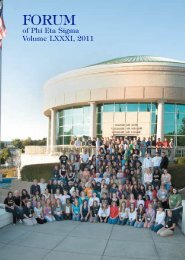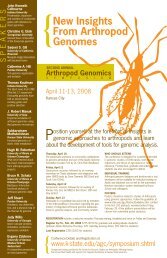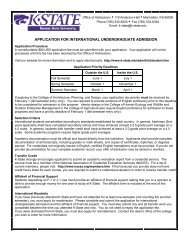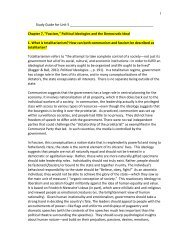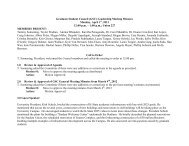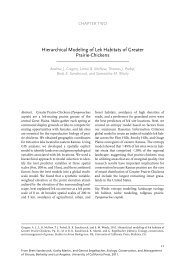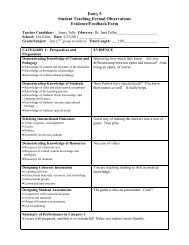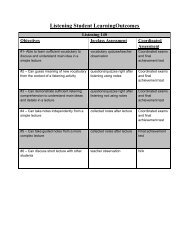Magliano, J. P., Loschky, L. C., Clinton, J., & Larson, A. M. (2013).
Magliano, J. P., Loschky, L. C., Clinton, J., & Larson, A. M. (2013).
Magliano, J. P., Loschky, L. C., Clinton, J., & Larson, A. M. (2013).
Create successful ePaper yourself
Turn your PDF publications into a flip-book with our unique Google optimized e-Paper software.
CHAPTER 8<br />
Is Reading the Same as Viewing?<br />
An Exploration of the Similarities and Differences<br />
Between Processing Text- and Visually Based Narratives<br />
Joseph P. <strong>Magliano</strong>, Lester C. <strong>Loschky</strong>, James A. <strong>Clinton</strong>, and Adam M. <strong>Larson</strong><br />
The title of this chapter explores to what extent there are shared<br />
cognitive systems that support the processing of narratives across<br />
print and visual media. An initially obvious answer to the question<br />
is no, given that viewing images and reading texts involve different<br />
cognitive and brain systems during encoding. In fact, we contend that<br />
there are aspects of how narratives are conveyed across media that may<br />
lead to differences in encoding that are less obvious. On the other hand, if<br />
we assume that mental models provide the basis of comprehension across<br />
modalities of experiences (McNamara & <strong>Magliano</strong>, 2009), surely there are<br />
shared cognitive systems that lead to the construction of these mental<br />
models (Gernsbacher, 1990; Gernsbacher, Varner, & Faust, 1990; <strong>Magliano</strong>,<br />
Radvansky, & Copeland, 2007).<br />
Consider the shot sequence from the James Bond movie Moonraker<br />
(Broccoli & Gilbert, 1979), shown in Figure 8.1, which constitutes about 15<br />
seconds of film. Just prior to this sequence, we find Bond on an airplane<br />
filled with enemy agents who want to kill him. Bond throws one of the<br />
bad guys (who has a parachute) out of the plane and then subsequently<br />
gets pushed out of the plane himself (without a parachute). Most viewers<br />
of this sequence infer that Bond has the goal to steal the parachute and will<br />
be successful in doing so at the start of Shot 6, when Bond starts his dive<br />
(<strong>Magliano</strong>, Dijkstra, & Zwaan, 1996). Upon review of the shot sequence in<br />
Figure 8.1, one can see that the sequence is carefully constructed to constrain<br />
the possible interpretation of the narrative events. More important, it<br />
illustrates some conventions in filmmaking that may not have correlates in<br />
text; but at the same time, the sequence also illustrates that there must be<br />
overlapping processes between film and text.<br />
Consider Shots 1 and 2, which are extreme, high-angle, long shots of<br />
two figures in the air and heading toward the earth. These shots establish<br />
the nature of a complication or problem for Bond to solve, specifically that<br />
he is falling through the air without a parachute. Shot 2 also introduces a<br />
potential solution to that problem, namely, the parachute possessed by the<br />
bad guy. Although processing the events conveyed in these camera shots<br />
may be different in many ways from processing analogous sentences in<br />
a text-based version of the narrative, in doing so viewers need to engage<br />
in mapping processes across the images that are also central to text<br />
78<br />
BRP-MILLER-13-0103-008.indd 78<br />
17/07/13 1:39 PM
Is Reading the Same as Viewing? 79<br />
Shot 1 Shot 4<br />
Shot 2 Shot 5<br />
Shot 3 Shot 6<br />
Figure 8.1. Shot summary of a scene from Moonraker.<br />
comprehension (McNamara & <strong>Magliano</strong>, 2009). For example, viewers must<br />
establish that the figures in Shots 1 and 2 are the previously seen Bond and<br />
the bad guy, respectively, and reinstate knowledge of which of these entities<br />
has or does not have a parachute. These mapping processes are akin to the<br />
kinds of bridging inferences we know that readers generate (e.g., anaphoric<br />
reference; see Graesser, Singer, & Trabasso, 1994, for an extensive review).<br />
Another issue to consider is that understanding the internal states<br />
of characters (goals, beliefs, emotions) is an important part of narrative<br />
comprehension (e.g., Graesser, Singer, & Trabasso, 1994). However, text<br />
and film may differ in the extent to which internal states can readily be<br />
conveyed. Authors can rely on a variety of narrative conventions to provide<br />
explicit information regarding the internal states of characters (e.g., free<br />
indirect speech, omniscient narration). However, filmmakers usually<br />
rely on dialogue to explicitly convey internal states of characters. Other<br />
techniques, such as voice-over, can be used to explicitly convey internal<br />
BRP-MILLER-13-0103-008.indd 79<br />
17/07/13 1:39 PM
80 <strong>Magliano</strong> et al.<br />
states of characters, but these are rarely used and not well received by<br />
critics. That said, there are filmmaking conventions for conveying internal<br />
states that build upon editing and actors’ facial expressions, body postures,<br />
and actions to help the viewer infer the internal states of a protagonist. For<br />
example, Shots 3 and 4 illustrate one important convention, namely, a pointof-view<br />
shot sequence. This is a shot sequence that shows a close-up of a<br />
character’s face, followed by eye-line match shots (i.e., a camera shot from<br />
the implied location of the characters’ eyes). This shot sequence is critical<br />
for conveying the internal states of characters (Bordwell & Thompson, 2003)<br />
but will always require the inference that the second shot is seen from the<br />
viewpoint of the character shown in the first shot. Based on that inference,<br />
in the case of the example in Figure 8.1, viewers must further infer that<br />
Bond is cognizant of the bad guy with the parachute, arguably a necessary<br />
condition for his generating the goal of stealing the parachute.<br />
As this example illustrates, to be able to give a detailed answer to the<br />
question of whether reading and viewing narratives are the same requires<br />
a detailed systematic investigation. We contend that such an investigation<br />
is critical for directing empirical studies in order to answer the question<br />
meaningfully. The goal of this chapter is to provide the start of such an<br />
investigation. We structure our discussion around features of the media,<br />
the psychological processes involved in processing and comprehending<br />
narratives across media, and research comparing processing across media.<br />
Features of the Media<br />
Any discussion regarding the similarities and differences in the cognitive<br />
processes that support narrative comprehension across media should start<br />
with a discussion of the nature of the media. Such an exploration can yield<br />
hypotheses suggesting where and when there will be divergences and convergences<br />
between media, which can then lead to future empirical studies.<br />
To this end, we have identified four dimensions that warrant consideration<br />
across the media of texts, graphic narratives, and films, which are shown<br />
in Table 8.1. These dimensions are by no means exhaustive; rather, they<br />
reflect the dimensions that we feel warrant consideration, given the goals<br />
of this chapter.<br />
One fundamental issue to consider is the minimal production unit of<br />
meaning, the smallest unit that needs to be processed to understand what<br />
is happening “now” in the narrative, namely, the salient events that make<br />
up the narrative plot. With narrative text, an obvious production unit of<br />
meaning is the sentence. It is easily recognized (in English) by starting with a<br />
capital letter and ending with specific punctuation (e.g., a period). Similarly,<br />
in such graphic narratives as comics, an obvious minimal production unit<br />
of meaning is the panel, which is also easily recognized by typically being<br />
bounded by a box. Finally, in film, a comparable minimal production unit<br />
of meaning is the shot, which is easily recognized by a change in camera<br />
BRP-MILLER-13-0103-008.indd 80<br />
17/07/13 1:39 PM
Is Reading the Same as Viewing? 81<br />
Table 8.1. Considerations regarding the media<br />
Dimension Text Graphic narrative Film<br />
Unit of meaning Sentence Panel Shot<br />
Multimodality Text Text and pictures Dialog, sounds, images<br />
Presentation control Self-paced Self-paced Generally not self-paced<br />
Plot structure Goal episodes Goal episodes Goal episodes<br />
angle and/or an editing boundary (e.g., a fade-out or dissolve). Each of<br />
these minimal production units is widely recognized by producers and<br />
consumers of these respective media.<br />
Nevertheless, there are certain problems with each of these minimal<br />
meaningful units from the standpoint of psychological processes that<br />
support comprehension. With text, a single sentence can include multiple<br />
clauses, each of which contains a subject and predicate (i.e., a verb phrase).<br />
Verbs in these clauses are particularly important in conveying the events<br />
that are being conveyed in a narrative (e.g., walking, stopping, and seeing;<br />
Zwaan, Langston, & Graesser, 1995). Much research has shown that as<br />
readers reach the end of each clause in a text, they update their representation<br />
to incorporate that information into the mental model that they are<br />
constructing (Gernsbacher, 1990). Thus, from a psycholinguistic standpoint,<br />
clauses seem more reasonable as a minimal unit of meaning than a sentence.<br />
Alternatively, one could also argue that the individual word is an even more<br />
minimal meaningful unit. Eye-movement studies have shown that readers<br />
fixate most words in a text sequentially (Rayner, 1998), and ease of word<br />
recognition is an important predictor of children’s reading development<br />
(Rayner, Foorman, Perfetti, Pesetsky, & Seidenberg, 2001).<br />
In the case of graphic narratives, the panel is also a somewhat<br />
problematic minimal meaningful unit. A given panel generally contains<br />
multiple objects (animate or inanimate) and one or more actions, either of<br />
which could be argued to be more appropriate minimal meaningful units.<br />
For example, in Figure 8.2 (The Fantom of the Fair, Gustavson, 1939), we see<br />
a man (the fantom) and a woman, each of which must be recognized, as<br />
well as their respective actions (flying, calling), in order to comprehend the<br />
event(s) in the panel. Such objects are rather comparable to concrete nouns<br />
in text processing, and their actions are comparable to verbs. Similarly, in<br />
film, a given shot usually contains multiple objects engaged in one or more<br />
actions. Thus, again, objects and their actions could be argued to be more<br />
appropriate minimal meaningful units. Furthermore, a given camera shot<br />
in film can convey several events, or several shots can be used to convey a<br />
single event.<br />
Finally, both graphic narratives and films usually contain language.<br />
Consider a panel excerpt from Gustavson’s 1939 graphic story The Fantom<br />
of the Fair (see Figure 8.2). The Fantom has just rescued a circus high-diver,<br />
Jane, and he is now flying away from her. Viewers have to integrate the<br />
BRP-MILLER-13-0103-008.indd 81<br />
17/07/13 1:39 PM
82 <strong>Magliano</strong> et al.<br />
YOU WILL HAVE TO<br />
GO THE REST OF<br />
THE WAY YOURSELF!<br />
I HAVE THINGS TO<br />
DO THAT REQUIRE<br />
GRREAT HASTE!<br />
BUT -- BUT --<br />
WAIT !!<br />
Figure 8.2. Example panel from Fantom of the Fair.<br />
dialogue with the images to understand what is happening now in the<br />
narrative moment. The same is true in film, where integration of both<br />
visual and linguistic processing is necessary for comprehension. Thus, one<br />
can ask whether the sentence (or clause, or word) should also be a minimal<br />
meaningful unit in graphic narratives and film.<br />
The next dimension that warrants discussion is the extent to which<br />
the narrative is a multimedia experience. Texts obviously are not, whereas<br />
graphic narratives and film are. Multimedia experiences can be complex<br />
to process because the comprehender has to integrate linguistic and<br />
perceptual information, which can place a higher cognitive load on the<br />
comprehender (Mayer, 2009). We suspect that graphic narratives are the<br />
most complex and resource demanding because they require text reading<br />
and pictorial comprehension. Consider again Figure 8.2 from The Fantom of<br />
the Fair (Gustavson, 1939). The dialog and image contain both convergent<br />
and divergent semantic content. An interesting empirical question is<br />
the extent to which the semantic overlap between these two sources of<br />
information affects comprehension.<br />
It is also important to understand that there are differences in the extent<br />
to which comprehenders can control the pacing of processing the narrative.<br />
With text and graphic narratives, comprehenders can control the pace<br />
at which they read and view. This allows comprehenders to pause, look<br />
back, reevaluate, and repair any comprehension problems. On the other<br />
hand, when viewing a film there is generally no control over the pacing. If<br />
comprehension problems arise, the viewer very often cannot or does not<br />
view that part of the film again. The exception is if the viewer has the ability<br />
to rewind. Whereas this option is available to individuals watching a film<br />
on their own viewing device, films are often watched in theaters or other<br />
BRP-MILLER-13-0103-008.indd 82<br />
17/07/13 1:39 PM
Is Reading the Same as Viewing? 83<br />
social settings in which rewinding is either not an option or is not generally<br />
taken advantage of to repair comprehension problems.<br />
Although the dimensions discussed thus far vary to one degree or<br />
another across the modalities, we contend that the final dimension, plot<br />
structure, does not. We argue that all narratives are structured around<br />
hierarchical goal episodes regardless of media (Trabasso, van den Broek, &<br />
Suh, 1989). Based on this assumption, we further assume that there will be<br />
commonalities in the mental models constructed by readers and viewers of<br />
comparable narratives. We will discuss empirical evidence supporting this<br />
claim in the context of the psychological processes involved in processing<br />
the different forms of media. One point that we do want to emphasize<br />
now, however, is that the different forms of media have different affordances<br />
in terms of which aspects of the goal episodes can be made explicit. As<br />
discussed above, films do not afford ways of explicitly conveying the<br />
internal states of characters (outside of dialogue or voice-over narration);<br />
thus viewers must instead infer them from the facial expressions, gestures,<br />
and actions of the actors. Conversely, this information can be stated explicitly<br />
in a text if an author chooses to do so. Given the importance of inferring<br />
and tracking goals of characters, one would think that this may make<br />
processing complex goals and internal states of characters more complex<br />
for narrative films more than for texts. However, basic emotions are readily<br />
inferred by facial expressions, and this inferencing skill is learned at an<br />
early age (McClure, 2000). Moreover, viewers appear to regularly monitor<br />
the goal states of characters when viewing a film (<strong>Magliano</strong>, Taylor, & Kim,<br />
2005). The extent to which viewers can infer internal state of characters in<br />
film (i.e., the kinds of internal states and their complexity) and how they do<br />
so warrant further investigation.<br />
Front-End and Back-End Processes Across Media<br />
We make a broad distinction between what we call front-end and backend<br />
processing of narrative media (<strong>Loschky</strong>, <strong>Magliano</strong>, & <strong>Larson</strong>, 2012).<br />
Front-end processes are those involved in extracting information from the<br />
visual stream, which lead to the computation of the event model that represents<br />
the “now” moment in a narrative. Table 8.2 shows a list of processes<br />
that compose front-end processing across the three media considered here.<br />
These processes cluster into those processes involved in processing language<br />
and those involved in scene perception. It is beyond the scope of this<br />
chapter to present a detailed discussion of each of these processes, however.<br />
Given that most readers of this volume will be more familiar with<br />
the language-based processes than with those that are film based, we do<br />
not describe them here. Nonetheless, a brief description of the processes<br />
involved in scene perception is warranted.<br />
When constructing a representation of the “now” moment in a scene,<br />
front-end processes begin by extracting visual information during each<br />
BRP-MILLER-13-0103-008.indd 83<br />
17/07/13 1:39 PM
84 <strong>Magliano</strong> et al.<br />
Table 8.2. Considerations regarding front-end and back-end processes<br />
Text Graphic narrative Film<br />
Front-end<br />
Processes<br />
Orthographic X X<br />
Phonological X X X<br />
Lexical–syntactic X X X<br />
Semantics X X X<br />
Gist processing X X<br />
Object processing X X<br />
Motion processing (X) X<br />
Product<br />
Event model X X X<br />
Back-end<br />
Processes<br />
Event segmentation X X X<br />
Inferences X X X<br />
Structure building X X X<br />
Products<br />
Text base X X ?<br />
Situation model X X X<br />
Note: (X) denotes that this process may be present.<br />
eye fixation. In scene perception, eye fixations last, on average, a third<br />
of a second, after which the eyes move to fixate a new object or location<br />
(Rayner, 1998). During the first 150 ms of the first fixation, front-end<br />
processes extract global semantic meaning from the scene, called scene gist<br />
(Fei-Fei, Iyer, Koch, & Perona, 2007). For example, the viewer will rapidly<br />
understand whether a scene is “natural” or “man made,” a “beach” or a<br />
“forest” (<strong>Loschky</strong> & <strong>Larson</strong>, 2010) and whether it has positive or negative<br />
emotional valence (Maljkovic & Martini, 2005). Likewise, the scene gist<br />
will also include global information about key objects in the scene, such<br />
as whether there are people or animals (Fei-Fei et al., 2007) and some idea<br />
of what action is being performed (<strong>Larson</strong>, Hendry, & <strong>Loschky</strong>, 2012). This<br />
scene gist representation will guide the eyes to fixate other objects to gather<br />
more detailed information (Eckstein, Drescher, & Shimozaki, 2006) and<br />
form the foundation of the event model. The event model will be further<br />
developed by the back-end processes in order to comprehend the dynamic<br />
structure of the visual narrative.<br />
One obvious observation that can be derived from Table 8.2 is that<br />
there is some shared overlap in processes, but this is most evident for<br />
the two forms of visually based narratives. Obviously, reading and scene<br />
perception involve some different cognitive and brain systems associated<br />
with encoding linguistic versus scenic input. However, there is a growing<br />
body of evidence for the perspective that language understanding is<br />
“grounded,” meaning that the brain systems that are involved in perceiving<br />
and moving through the world support the processing of language (e.g.,<br />
BRP-MILLER-13-0103-008.indd 84<br />
17/07/13 1:39 PM
Is Reading the Same as Viewing? 85<br />
Zwaan, 2004). It is beyond the scope of this chapter to discuss this literature;<br />
rather, we will focus on the shared overlap in language processing across<br />
the three media.<br />
The primary difference between the linguistic demands of reading<br />
(whether it be in the context of texts or graphic narratives) and film is that<br />
graphemic processing is minimal in film because most of the language<br />
is presented aurally. As such, there are fewer reading demands on the<br />
cognitive system during front-end processing of film. Indeed, preliterate<br />
children begin to develop narrative comprehension skills by viewing purely<br />
visually based narratives (Trabasso & Nickels, 1992). However, a large body<br />
of evidence shows that oral language skills are important for narrative<br />
comprehension, as reflected in the Simple View of Reading model (Gough<br />
& Tunmer, 1986). This evidence raises an interesting empirical question as<br />
to whether these skills account for variance in individual differences in<br />
comprehending film.<br />
Another interesting case is comprehending graphic narratives. As we<br />
have discussed, this multimedia experience involves both reading and<br />
visual processing skills. It makes sense that the visual images could serve<br />
as a scaffold for processing the language, but as mentioned above, this is<br />
completely contingent on the semantic overlap between the texts and the<br />
images. In the panel of examples in Figure 8.2, the text is in the form of<br />
dialogue between the characters and conveys additional information not<br />
contained in the image (e.g., the fantom has other pressing business), and<br />
thus elaborates upon the image and explains why the fantom is leaving<br />
Jane.<br />
A critically important difference between graphic narratives and film<br />
is that film contains motion, but graphic narratives do not. This leads to<br />
greater attentional synchrony, in which different viewers look at the same<br />
things at the same time when viewing a film as opposed to when viewing a<br />
sequence of related still images (e.g., in a graphic narrative; Dorr, Martinetz,<br />
Gegenfurtner, & Barth, 2010). 1 Nevertheless, other research has shown<br />
that still images that imply motion, which is ubiquitous in comics, lead<br />
to greater activation of motion-processing brain regions (e.g., area MT)<br />
than do still images that do not imply motion (Osaka, Matsuyoshi, Ikeda,<br />
& Osaka, 2010). Thus, even graphic narratives with static images seem to<br />
involve some degree of motion processing. To our knowledge there is scant<br />
research comparing processing of graphic narratives versus film. However,<br />
there is a substantial literature on multimedia learning that could guide<br />
systematic study of these media.<br />
We identified three back-end processes that lead to a mental model<br />
(i.e., the product of back-end processes). This mental model contains two<br />
products, the textbase, which corresponds to the explicitly experienced<br />
1<br />
This difference in attentional synchrony is also likely related to the fact that in<br />
normal film viewing, the filmmaker sets the viewing pace, whereas with comics the<br />
viewer or reader controls the pace, likely producing less attentional synchrony.<br />
BRP-MILLER-13-0103-008.indd 85<br />
17/07/13 1:39 PM
86 <strong>Magliano</strong> et al.<br />
content, and the situation model, which includes the inferences that are<br />
generated in order to coherently connect that content to world knowledge<br />
(e.g., Kintsch, 1998). The mental model is generally believed to be structured<br />
around a hierarchically organized sequence of goal episodes (e.g., Trabasso<br />
et al., 1989). There is good evidence that viewers of graphic narratives and<br />
film produce situation models, for they clearly draw inferences that require<br />
integrating information from what they saw and their prior knowledge (e.g.,<br />
<strong>Magliano</strong> et al., 1996). However, we know of no clear evidence indicating<br />
whether film viewers form a language-like propositional representation of<br />
what they saw, which we could call a textbase.<br />
The first of the back-end processes is event segmentation, which involves<br />
understanding the boundaries between story episodes (e.g., Kurby & Zacks,<br />
2008). As will be discussed below, viewers and readers segment narratives<br />
based on changes in such story dimensions as space, time, causality, and the<br />
goal episode (e.g., <strong>Magliano</strong>, Kopp, McNerney, Radvansky, & Zacks, 2012).<br />
The next process involves inferencing, which primarily involves establishing<br />
relationships between explicitly experienced story elements and drawing<br />
upon relevant background knowledge (McNamara & <strong>Magliano</strong>, 2009).<br />
Finally, both event segmentation and inferencing are in the service of<br />
structure building, which constitutes several processes involved in building<br />
mental models (laying the foundation, mapping, shifting to new mental<br />
structures, inference generation; Gernsbacher, 1990).<br />
Psychological Research<br />
Comparing Comprehension Across Media<br />
A number of scholars who study discourse comprehension have argued<br />
that models of discourse comprehension can be viewed as general models<br />
that extend to other media and even naturalistic events (Gernsbacher, 1990;<br />
Kintsch, 1998; <strong>Magliano</strong> et al., 2007). However, there are very few empirical<br />
investigations of that claim, in particular when controlling for content<br />
(e.g., Baggett, 1979; <strong>Magliano</strong> et al., in press). There have been a number of<br />
studies that have assessed the extent to which comprehension skills and<br />
proficiencies share variance (e.g., Gernsbacher et al., 1990; Kendeou, Bohn-<br />
Gettler, White, & van den Broek, 2008; Pezdek, Lehrer, and Simon, 1984). In<br />
this section, we discuss both of these lines of research.<br />
Baggett (1979) conducted a seminal study assessing whether mental<br />
models for text-based and visually based narratives were similar. Across<br />
several experiments, college student participants were asked to identify<br />
the goal episodes that composed the film The Red Balloon (Lamorisse, 1956).<br />
However, they either read a text-based version of the story, viewed the filmbased<br />
version of it, or looked at still picture frames from it. Participants<br />
identified the same goal episodes regardless of the medium. In addition,<br />
in one experiment they were asked to recall the narratives; the content of<br />
the recall protocols was remarkably similar in content and structure. This<br />
BRP-MILLER-13-0103-008.indd 86<br />
17/07/13 1:39 PM
Is Reading the Same as Viewing? 87<br />
study provided fairly convincing evidence that back-end processes are<br />
surprisingly similar regardless of the modality of the experience.<br />
A more recent study was conducted by <strong>Magliano</strong>, Kopp, McNerney,<br />
Radvansky, and Zacks (2012). The researchers had participants (college<br />
students or older adults) view a popular series of children’s picture stories<br />
that contained only images and no language or read a version for which the<br />
researchers wrote text that captured the major events depicted. Participants<br />
identified when they perceived boundaries between the events that made<br />
up the stories. The researchers found remarkable convergences in the event<br />
boundary judgments within and across the two media, albeit convergence<br />
was greater within a medium than across the two.<br />
Next consider research that has explored the extent to which<br />
comprehension is similar or different across media (i.e., text and film),<br />
which has produced conflicting evidence. For example, Pezdek, Lehrer,<br />
and Simon (1984) found that there was minimal shared variance in<br />
comprehension skill across media. They had children (8–11 years old) listen<br />
to (oral text), read (graphic narratives combining language and images), or<br />
view (TV) different versions of the same story. The researchers assessed<br />
comprehension in a variety of ways but found no significant overall<br />
difference between television comprehension and reading comprehension<br />
scores. However, they found that comprehension scores across the<br />
media were not significantly correlated, suggesting that comprehension<br />
proficiencies were not similar, at least for children at this age. On the<br />
other hand, Kendeou, Bohn-Gettler, White, and van den Broek (2008) had<br />
children (6–8 year olds) listen to, read, or view narratives and assessed<br />
comprehension proficiencies. A notable difference from the Pezdek et al.<br />
(1984) study was that the children’s inferencing skills across the media<br />
were consistently, albeit moderately, correlated—demonstrating a stronger<br />
convergence across back-end processes than found in the earlier study. The<br />
divergence of these two studies clearly indicates that this issue warrants<br />
further investigation. Nevertheless, across the five studies considered here<br />
(Baggett, 1979; Gernsbacher et al., 1990; Kendeou et al., 2008; <strong>Magliano</strong> et al.,<br />
in press; Pezdek et al., 1984), there is converging evidence for both shared<br />
processes and proficiencies in narrative comprehension across textual and<br />
visual media.<br />
Concluding Remarks and<br />
Promising Future Directions<br />
This chapter was necessarily a general overview of an area of theoretical<br />
and empirical explorations that shows great promise. We believe that our<br />
distinction between front-end and back-end processes provides a heuristic<br />
for future research and deeper reflection that has validity in reading,<br />
vision, and comprehension sciences. We conclude this chapter by identifying<br />
what we believe to be some interesting future research directions. One<br />
BRP-MILLER-13-0103-008.indd 87<br />
17/07/13 1:39 PM
88 <strong>Magliano</strong> et al.<br />
caveat is that each research suggestion warrants greater discussion than is<br />
afforded here.<br />
One critical line of research that warrants further exploration is the<br />
extent to which comprehension processes are functionally similar across<br />
media. We provided a framework for this exploration with the introduction<br />
of the distinction between front- and back-end processes. Although we have<br />
argued that back-end processes likely share larger overlap across media<br />
than do front-end processes, it is important to recognize that such front-end<br />
processes as eye movements and fixations are heavily guided by back-end<br />
processes, such as what one is trying to comprehend at that moment. For<br />
example, consistent with results from reading (Anderson & Pichert, 1978),<br />
viewers of pictures of home interiors looked at different objects for different<br />
amounts of time depending on whether they took the perspective of a home<br />
buyer or a burglar, which in turn influenced their memory (Kaakinen,<br />
Hyönä, & Viljanen, 2011). Further research on the effects of back-end<br />
processes on front-end processes across media is greatly needed.<br />
As a second issue, there is growing evidence that both linguistic<br />
and grounded systems (i.e., perceptual and embodied symbols) support<br />
comprehension processes (e.g., Fincher-Kiefer, 2001). However, still an open<br />
question is the extent to which these different types of representations are<br />
involved while perceiving and comprehending narratives presented in<br />
different media (e.g., text, graphic novel, or movie). Specifically, are the roles<br />
of linguistic and grounded symbols in the representation of linguistic and<br />
visually based narratives similar or different?<br />
A final issue that warrants exploration pertains to the topic of<br />
this volume. Specifically, what factors affect individual differences in<br />
comprehension ability across different media? Do the same factors that<br />
predict individual differences in the comprehension of texts also account<br />
for individual differences in visually based narratives? The research<br />
discussed in this chapter indicates that the answer to this question is<br />
currently equivocal. Similarly, do individuals who have disorders known<br />
to negatively affect language comprehension, such as dyslexia or autism<br />
spectrum disorder, similarly experience troubles comprehending visually<br />
based narratives? If not, can visually based narratives be used in the context<br />
of interventions as a scaffold to promote language comprehension skills of<br />
such individuals?<br />
Although the foregoing list of possibilities is by no means exhaustive, we<br />
believe it points to a rich future for research in comprehension across media.<br />
By conducting this research, we will gain better insights into the nature of<br />
comprehension and the cognitive and brain systems that support it.<br />
References<br />
Anderson, R.C., & Pichert, J.W. (1978). Recall<br />
of previously unrecallable information<br />
following a shift in perspective.<br />
Journal of Verbal Learning and Verbal<br />
Behavior, 17(1), 1–12. doi:10.1016/s0022-<br />
5371(78)90485-1<br />
BRP-MILLER-13-0103-008.indd 88<br />
17/07/13 1:39 PM
Is Reading the Same as Viewing? 89<br />
Baggett, P. (1979). Structurally equivalent<br />
stories in movie and text and the effect<br />
of the medium on recall. Journal of<br />
Verbal Learning & Verbal Behavior, 18(3),<br />
333–356.<br />
Bordwell, D., & Thompson, K. (2003).<br />
Film art: An introduction. New York, NY:<br />
McGraw-Hill.<br />
Broccoli, A.R.P., & Gilbert, L.D. (Writers).<br />
(1979). Moonraker [Film]. Available from<br />
CBS/Fox Video, Industrial Park Drive,<br />
Farmington Hills, MI 48024.<br />
Dorr, M., Martinetz, T., Gegenfurtner,<br />
K.R., & Barth, E. (2010). Variability of<br />
eye movements when viewing dynamic<br />
natural scenes. Journal of Vision, 10(10),<br />
1–17.<br />
Eckstein, M.P., Drescher, B.A., & Shimozaki,<br />
S.S. (2006). Attentional cues in real<br />
scenes, saccadic targeting, and Bayesian<br />
priors. Psychological Science, 17(11),<br />
973–980.<br />
Fei-Fei, L., Iyer, A., Koch, C., & Perona, P.<br />
(2007). What do we perceive in a glance<br />
of a real-world scene? Journal of Vision,<br />
7(1), 1–29.<br />
Fincher-Kiefer, R. (2001). Perceptual components<br />
of situation models. Memory &<br />
Cognition, 29, 336–343.<br />
Gernsbacher, M.A. (1990). Language comprehension<br />
as structure building (Vol. 11).<br />
Hillsdale, NJ: Erlbaum.<br />
Gernsbacher, M.A., Varner, K.R., & Faust,<br />
M.E. (1990). Investigating differences in<br />
general comprehension skill. Journal of<br />
Experimental Psychology: Learning, Memory,<br />
and Cognition, 16(3), 430–445.<br />
Gough, P., & Tunmer, W. (1986). Decoding,<br />
reading, and reading disability. Remedial<br />
and Special Education, 7, 6–10.<br />
Graesser, A.C., Singer, M., & Trabasso, T.<br />
(1994). Constructing inferences during<br />
narrative text comprehension. Psychological<br />
Review, 101, 371–395.<br />
Gustavson, P. [Artist]. (1939). The fantom<br />
of the fair [Public domain comic strip].<br />
Available from http://goldenagecomics.<br />
co.uk<br />
Kaakinen, J.K., Hyönä, J., & Viljanen,<br />
M. (2011). Influence of a psychological<br />
perspective on scene viewing and<br />
memory for scenes. Quarterly Journal of<br />
Experimental Psychology, 64(7), 1372–1387.<br />
doi:10.1080/17470218.2010.548872<br />
Kendeou, P., Bohn-Gettler, C., White,<br />
M.J., & van den Broek, P. (2008). Children’s<br />
inference generation across<br />
different media. Journal of Research in<br />
Reading, 31(3), 259–272. doi:10.1111/j.1467-<br />
9817.2008.00370.x<br />
Kintsch, W. (1998). Comprehension: A<br />
paradigm for cognition. New York, NY:<br />
Cambridge University Press.<br />
Kurby, C.A., & Zacks, J.M. (2008). Segmentation<br />
in the perception and memory of<br />
events. Trends in Cognitive Sciences, 12,<br />
72–79.<br />
Lamorisse, A. (Writer). (1956). The red<br />
balloon [Film]. Paris, France: Films<br />
Montsouris.<br />
<strong>Larson</strong>, A.M., Hendry, J., & <strong>Loschky</strong>, L.C.<br />
(2012, May). Scene gist meets event perception:<br />
The Time course of scene gist and event<br />
recognition. Poster presented at the 12th<br />
annual meeting of the Vision Sciences<br />
Society, Naples, FL.<br />
<strong>Loschky</strong>, L.C., & <strong>Larson</strong>, A.M. (2010). The<br />
natural/man-made distinction is made<br />
prior to basic-level distinctions in scene<br />
gist processing. Visual Cognition, 18(4),<br />
513–536.<br />
<strong>Loschky</strong>, L.C., <strong>Magliano</strong>, J.P., & <strong>Larson</strong>,<br />
A.M. (2012). The need for an integrated<br />
theory of film perception and comprehension.<br />
Paper presented at the Workshop<br />
on Intelligent Cinematography and<br />
Editing 2012 workshop, Raleigh, NC.<br />
<strong>Magliano</strong>, J.P., Dijkstra, K., & Zwaan, R.<br />
(1996). Generating predictive inferences<br />
while viewing a movie. Discourse Processes,<br />
22, 199–224.<br />
<strong>Magliano</strong>, J.P., Kopp, K., McNerney, M.W.,<br />
Radvansky, G.A., & Zacks, J.M. ( 2012).<br />
Aging and perceived event structure as<br />
a function of modality. Aging, Neuropsychology,<br />
and Cognition, 19, 264–282.<br />
<strong>Magliano</strong>, J.P., Radvansky, G.A., & Copeland,<br />
D.E. (2007). Beyond language<br />
comprehension: Situation models as<br />
a form or autobiographical memory.<br />
In F. Schmalhofer & C. Perfetti (Eds.),<br />
Higher level language processes in the brain:<br />
Inference and comprehension processes<br />
(pp. 379–391). Mahwah, NJ: Erlbaum.<br />
<strong>Magliano</strong>, J.P., Taylor, H.A., & Kim, H.J.<br />
(2005). When goals collide: Monitoring<br />
the goals of multiple characters. Memory<br />
& Cognition, 33, 1357–1367.<br />
Maljkovic, V., & Martini, P. (2005). Shortterm<br />
memory for scenes with affective<br />
content. Journal of Vision, 5(3), 215–229.<br />
Mayer, R.E. (2009). Multimedia learning<br />
(2nd ed.). New York, NY: Cambridge<br />
University Press.<br />
BRP-MILLER-13-0103-008.indd 89<br />
17/07/13 1:39 PM
90 <strong>Magliano</strong> et al.<br />
McClure, E.B. (2000). A meta-analytic review<br />
of sex differences in facial expression<br />
processing and their development<br />
in infants, children, and adolescents.<br />
Psychological Bulletin, 126(3), 424–453.<br />
McNamara, D.S., & <strong>Magliano</strong>, J.P. (2009).<br />
Towards a comprehensive model of<br />
comprehension. In B. Ross (Ed.), The<br />
psychology of learning and motivation<br />
(Vol. 51, pp. 297–384). New York, NY:<br />
Elsevier Science.<br />
Osaka, N., Matsuyoshi, D., Ikeda, T., &<br />
Osaka, M. (2010). Implied motion because<br />
of instability in Hokusai Manga<br />
activates the human motion-sensitive<br />
extrastriate visual cortex: An fMRI<br />
study of the impact of visual art. NeuroReport:<br />
For Rapid Communication of<br />
Neuroscience Research, 21(4), 264–267.<br />
doi:10.1097/WNR.0b013e328335b371<br />
Pezdek, K., Lehrer, A., & Simon, S. (1984).<br />
The relationship between reading and<br />
cognitive processing of television and<br />
radio. Child Development, 55, 2072–2082.<br />
Rayner, K. (1998). Eye movements in<br />
reading and information processing: 20<br />
years of research. Psychological Bulletin,<br />
124(3), 372–422.<br />
Rayner, K., Foorman, B.R., Perfetti, C.A.,<br />
Pesetsky, D., & Seidenberg, M.S. (2001).<br />
How psychological science informs the<br />
teaching of reading. Psychological Science<br />
in the Public Interest, 2(2), 31–74.<br />
Trabasso, T., & Nickels, M. (1992). The development<br />
of goal plans of action in the<br />
narration of picture stories. Discourse<br />
Processes, 15, 249–275.<br />
Trabasso, T., van den Broek, P., & Suh, S.<br />
(1989). Logical necessity and transitivity<br />
of causal relations in stories. Discourse<br />
Processes, 12, 1–25.<br />
Zwaan, R.A. (2004). The immersed experiencer:<br />
Toward an embodied theory of<br />
language comprehension. In B.H. Ross<br />
(Ed.), The psychology of learning and motivation<br />
(pp. 35–62). New York, NY: Academic<br />
Press.<br />
Zwaan, R.A., Langston, M.C., & Graesser,<br />
A.C. (1995). The construction of situation<br />
models in narrative comprehension:<br />
An event-indexing model. Psychological<br />
Science, 6, 292–297.<br />
BRP-MILLER-13-0103-008.indd 90<br />
17/07/13 1:39 PM



